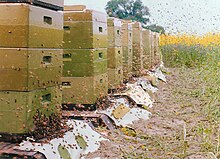Wandering (bees)

Hiking referred to in the apiary or the movement of bee colonies to another location. Beekeepers spend bee colonies in a locked hive (dwelling) by means of vehicles, such as cars with trailers, delivery vehicles, trucks, to another location . The main purpose of bee migrations is to achieve a better honey harvest through the use of different traditional costumes . Migrations are also undertaken when the bee colonies are sold or for pollination purposes.
history

Beehives were already transported on the Nile in ancient Egypt . Even in heather beekeeping , which has become rare today, it was common for bees to move to another, more favorable location for centuries.
Since the advent of freight transport with the rapidly developing railroad in the 19th century , it was also used for transporting bees, initially in various European countries and in Russia , and later also in the USA and other countries. Until the beginning of the 20th century, however, mostly only individual beehives or a few bee colonies were transported "by rail" and not "by axle" ( horse-drawn cart ). The Austro-Hungarian large beekeeper Leopold Gombocz (1875–1943) from Laafeld in Styria was one of the first beekeepers to use the new means of transport for bee migration on a large scale and to take several hundred bee colonies by train to distant locations.
practice


Wandering is done at a time of day when the beekeeper can be sure that there are as few bees as possible outside of the hive. Therefore, bee migrations preferably take place early in the morning, late in the evening or at night. In addition, it is then cooler and the bees remain calmer during transport.
The beehives are locked for hiking. Modern beehives have flaps or foam rubber strips to close the entrance hole. In addition, most of the beehives have an open, air-permeable floor with an insect screen (so-called grid floor). For magazine hives there are traveling attachments made of gauze , so that the hive is open at the top, but the bees cannot escape. Occasionally beekeepers spray water on the bees from above to lower the temperature in the colony. A great danger when hiking is that the bee colonies froth: if there is restlessness or insufficient heat dissipation, bees can generate such high temperatures that honeycombs, honey and bees merge.
The new location must be at least 2 km away from the old location so that the flying bees cannot return to the previous location known to them. The bees need about half a day to find their way around the new location.
It makes sense to hike with bees to increase the honey yield and to ensure the pollination of crops ( fruit growing , rape , special crops ). Beekeepers also migrate to blooming fields in early spring or late summer in order to supply the bees with a large supply of pollen .
Bee migration is also necessary when selling bee colonies to other beekeepers and when setting up and supplying mating stations .
Legal regulations (Germany)
In order to prevent the spread of bee diseases, especially foulbrood, through migration, there are protective provisions in Germany. At the federal level, the Bee Disease Ordinance (Bienenseuchen-VO) contains prophylactic hiking regulations in § 5 (1) and (3) . Accordingly, the relocation of bee colonies must be reported immediately after the arrival of the responsible body at the new location (usually the veterinary office of the district) with a valid certificate from the civil servant veterinarian responsible for the place of origin. The health certificate must show that the colonies are free from American foulbrood and that their place of origin is not in a foulbrood restricted area.
Furthermore, there are state bee laws in the federal states (example: Mecklenburg-Western Pomerania - LBienG MV) and also regulations in individual districts. In Baden-Württemberg, for example, health certificates are issued by bee experts , the migration to a new location can also be reported there to the hiking warden of the locally responsible beekeeping association, and offshoots can be moved to a new location without a health certificate if there are no concerns about disease control and the mother colony (s) have valid health certificates.
According to the Bee Disease Regulation, a health certificate is valid if it was not issued before September 1st of the previous calendar year and is not older than nine months.
literature
- Barbara Holzschuster: American (vicious) foulbrood of the honeybee (Apis mellifera L.): on the large-scale spread through migration with bees . Dissertation . University of Veterinary Medicine Vienna, Institute for Hydrobiology, Fish and Apiculture, Vienna November 2001. (obv)
- Gottfried Stecher: Study on current problems of bee migration, in particular the planned use of bee colonies for pollinating agricultural crops with special consideration of fruit growing. Thesis. Berlin Humboldt University, Berlin 1982, OCLC 917087662 .
- Karl Weiß: The weekend beekeeper - a school for beekeeping with magazines. Ehrenwirth, Munich 1980, ISBN 3-431-02275-8 .
Web links
- Bieneninstitut Celle : Bee migration - the transfer of bee colonies from a legal point of view (pdf; 24 kB)
- Law for the protection of the bee mating sites and the regulation of the bee migration (State Bee Law Mecklenburg-Western Pomerania - LBienG MV)
- Law regulating the migration of bees and protecting mating sites of January 10, 1953.
Individual evidence
- ↑ Alois Alfonsus: General textbook of beekeeping. Moritz Perles Verlag, Vienna 1905, p. 438 ff.
- ^ Maryan Alber: Styrian memories. In: World of bees. The trade journal for the contemporary beekeeper. Leopold Stocker Verlag, edition No. 1–3, Graz 1959, ISSN 0006-2146 , p. 151 ff. ( Specialist article on beekeeping in Styria )